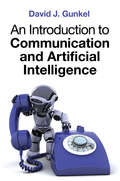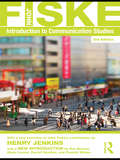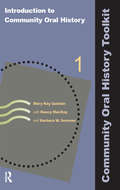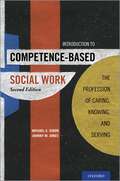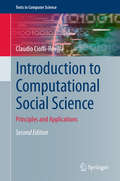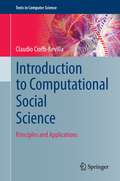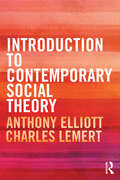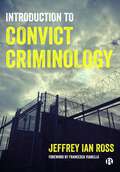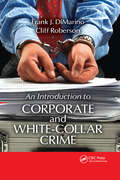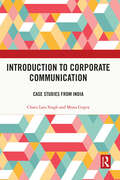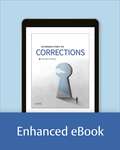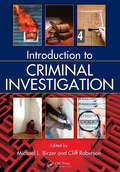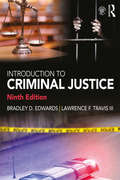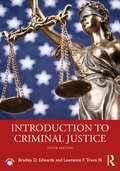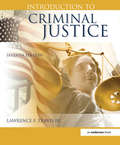- Table View
- List View
An Introduction to Communication and Artificial Intelligence
by David J. GunkelCommunication and artificial intelligence (AI) are closely related. It is communication – particularly interpersonal conversational interaction – that provides AI with its defining test case and experimental evidence. Likewise, recent developments in AI introduce new challenges and opportunities for communication studies. Technologies such as machine translation of human languages, spoken dialogue systems like Siri, algorithms capable of producing publishable journalistic content, and social robots are all designed to communicate with users in a human-like way. This timely and original textbook provides educators and students with a much-needed resource, connecting the dots between the science of AI and the discipline of communication studies. Clearly outlining the topic's scope, content and future, the text introduces key issues and debates, highlighting the importance and relevance of AI to communication studies. In lively and accessible prose, David Gunkel provides a new generation with the information, knowledge, and skills necessary to working and living in a world where social interaction is no longer restricted to humans. The first work of its kind, An Introduction to Communication and Artificial Intelligence is the go-to textbook for students and scholars getting to grips with this crucial interdisciplinary topic.
Introduction to Communication Studies
by John FiskeThis revised edition of a now classic text includes a new introduction by Henry Jenkins, explaining ‘Why Fiske Still Matters’ for today’s students, followed by a discussion between former Fiske students Ron Becker, Elana Levine, Darrell Newton and Pamela Wilson on the theme of ‘Structuralism and Semiotics, Fiske-Style’. Both underline the continuing relevance of this foundational text in communication studies. How can we study communication? What are the main theories and methods of approach? This classic text provides a lucid, accessible introduction to the main authorities in the field of communication studies, aimed at students coming to the subject for the first time. It outlines a range of methods of analysing examples of communication, and describes the theories underpinning them. Thus armed, the reader will be able to tease out the latent cultural meanings in such apparently simple communications as news photos or popular TV programmes, and to see them with new eyes.
Introduction to Communication Studies (PDF)
by John FiskeThis revised edition of a now classic text includes a new introduction by Henry Jenkins, explaining ‘Why Fiske Still Matters’ for today’s students, followed by a discussion between former Fiske students Ron Becker, Elana Levine, Darrell Newton and Pamela Wilson on the theme of ‘Structuralism and Semiotics, Fiske-Style’. Both underline the continuing relevance of this foundational text in communication studies. How can we study communication? What are the main theories and methods of approach? This classic text provides a lucid, accessible introduction to the main authorities in the field of communication studies, aimed at students coming to the subject for the first time. It outlines a range of methods of analysing examples of communication, and describes the theories underpinning them. Thus armed, the reader will be able to tease out the latent cultural meanings in such apparently simple communications as news photos or popular TV programmes, and to see them with new eyes.
Introduction to Community Oral History (Community Oral History Toolkit)
by Nancy MacKay Barbara W Sommer Mary Kay QuinlanThe first book of the five-volume Community Oral History Toolkit sets the stage for an oral history project by placing community projects into a larger context of related fields and laying a sound theoretical foundation. It introduces the field of oral history to newcomers, with discussions of the historical process, the evolution of oral history as a research methodology, the nature of community, and the nature of memory. It also elaborates on best practices for community history projects and presents a detailed overview of the remaining volumes of the Toolkit, which cover Planning, Management, Interviewing, and After-the-Interview processing and curation. Introduction to Community Oral History features a comprehensive glossary, index, bibliography, and references, as well as numerous sample forms that are needed throughout the process of conducting community oral history projects.
Introduction to Community Oral History (Community Oral History Toolkit #1)
by Nancy MacKay Barbara W Sommer Mary Kay QuinlanThe first book of the five-volume Community Oral History Toolkit sets the stage for an oral history project by placing community projects into a larger context of related fields and laying a sound theoretical foundation. It introduces the field of oral history to newcomers, with discussions of the historical process, the evolution of oral history as a research methodology, the nature of community, and the nature of memory. It also elaborates on best practices for community history projects and presents a detailed overview of the remaining volumes of the Toolkit, which cover Planning, Management, Interviewing, and After-the-Interview processing and curation. Introduction to Community Oral History features a comprehensive glossary, index, bibliography, and references, as well as numerous sample forms that are needed throughout the process of conducting community oral history projects.
Introduction to Competence-Based Social Work: The Profession of Caring, Knowing, and Serving
by Michael E. Sherr Johnny M. JonesSocial work is rooted in the values of service, social justice, and strong interpersonal relationships, but as the profession evolves, so must the approach to education. Michael E. Sherr and Johnny M. Jones have created an introductory textbook written for the future of social work. The second edition integrates the knowledge of practice, policy, research, HBSE, and field work with the skills and practice behaviors necessary for students to become fully competent social workers by the time they graduate. Students are introduced to social work through a "Why We Do, What We Do" model that emphasizes how and why social workers commit to their careers. 41 case vignettes, 16 of which are new, engage students and present a clear picture of the profession to help them become invested in enhancing and restoring the well-being of individuals, groups, and communities. Visit www.oup-arc.com for student and instructor resources.
Introduction to Competence-Based Social Work: The Profession of Caring, Knowing, and Serving
by Michael E. Sherr Johnny M. JonesSocial work is rooted in the values of service, social justice, and strong interpersonal relationships, but as the profession evolves, so must the approach to education. Michael E. Sherr and Johnny M. Jones have created an introductory textbook written for the future of social work. The second edition integrates the knowledge of practice, policy, research, HBSE, and field work with the skills and practice behaviors necessary for students to become fully competent social workers by the time they graduate. Students are introduced to social work through a "Why We Do, What We Do" model that emphasizes how and why social workers commit to their careers. 41 case vignettes, 16 of which are new, engage students and present a clear picture of the profession to help them become invested in enhancing and restoring the well-being of individuals, groups, and communities. Visit www.oup-arc.com for student and instructor resources.
Introduction to Computational Social Science: Principles and Applications (Texts in Computer Science)
by Claudio Cioffi-RevillaThis textbook provides a comprehensive and reader-friendly introduction to the field of computational social science (CSS). Presenting a unified treatment, the text examines in detail the four key methodological approaches of automated social information extraction, social network analysis, social complexity theory, and social simulation modeling. This updated new edition has been enhanced with numerous review questions and exercises to test what has been learned, deepen understanding through problem-solving, and to practice writing code to implement ideas. Topics and features: contains more than a thousand questions and exercises, together with a list of acronyms and a glossary; examines the similarities and differences between computers and social systems; presents a focus on automated information extraction; discusses the measurement, scientific laws, and generative theories of social complexity in CSS; reviews the methodology of social simulations, covering both variable- and object-oriented models.
Introduction to Computational Social Science: Principles and Applications (Texts in Computer Science)
by Claudio Cioffi-RevillaThis reader-friendly textbook is the first work of its kind to provide a unified Introduction to Computational Social Science (CSS). Four distinct methodological approaches are examined in detail, namely automated social information extraction, social network analysis, social complexity theory and social simulation modeling. The coverage of these approaches is supported by a discussion of the historical context, as well as by a list of texts for further reading. Features: highlights the main theories of the CSS paradigm as causal explanatory frameworks that shed new light on the nature of human and social dynamics; explains how to distinguish and analyze the different levels of analysis of social complexity using computational approaches; discusses a number of methodological tools; presents the main classes of entities, objects and relations common to the computational analysis of social complexity; examines the interdisciplinary integration of knowledge in the context of social phenomena.
Introduction to Contemporary Social Theory
by Anthony Elliott Charles LemertIn this comprehensive, stylish and accessible introduction to contemporary social theory, Anthony Elliott and Charles Lemert examine the major theoretical traditions from the Frankfurt School to globalization and beyond. When first published, the book’s wide range set new standards for introductory textbooks – social theorists discussed include Theodor Adorno, Herbert Marcuse, Michel Foucault, Jacques Lacan, Jacques Derrida, Anthony Giddens, Pierre Bourdieu, Julia Kristeva, Jurgen Habermas, Judith Butler, Slavoj Zizek, Manuel Castells, Ulrich Beck, Zygmunt Bauman, Giorgio Agamben and Manuel De Landa. Extensively developed to take into account significant recent developments in American social theory, the book offers chapters on American pragmatism, structural functionalism, ethnomethodology, black feminist thought and world-systems theory. American traditions of social theory are brought powerfully to life in treatments of intellectuals ranging from William James to Robert K. Merton, David Riesman to Randall Collins, and Patricia Hill Collins to Saskia Sassen. Introduction to Contemporary Social Theory combines lively exposition and clarity with reflective social critique and original insights, and is a superb textbook with which to navigate the twists and turns of contemporary social theory as taught in the disciplines of sociology, politics, history, cultural studies and many more.
Introduction to Contemporary Social Theory
by Anthony Elliott Charles LemertIn this comprehensive, stylish and accessible introduction to contemporary social theory, Anthony Elliott and Charles Lemert examine the major theoretical traditions from the Frankfurt School to globalization and beyond. When first published, the book’s wide range set new standards for introductory textbooks – social theorists discussed include Theodor Adorno, Herbert Marcuse, Michel Foucault, Jacques Lacan, Jacques Derrida, Anthony Giddens, Pierre Bourdieu, Julia Kristeva, Jurgen Habermas, Judith Butler, Slavoj Zizek, Manuel Castells, Ulrich Beck, Zygmunt Bauman, Giorgio Agamben and Manuel De Landa. Extensively developed to take into account significant recent developments in American social theory, the book offers chapters on American pragmatism, structural functionalism, ethnomethodology, black feminist thought and world-systems theory. American traditions of social theory are brought powerfully to life in treatments of intellectuals ranging from William James to Robert K. Merton, David Riesman to Randall Collins, and Patricia Hill Collins to Saskia Sassen. Introduction to Contemporary Social Theory combines lively exposition and clarity with reflective social critique and original insights, and is a superb textbook with which to navigate the twists and turns of contemporary social theory as taught in the disciplines of sociology, politics, history, cultural studies and many more.
Introduction to Convict Criminology
by Jeffrey Ian RossConvict criminology (CC) is based on the belief that the convict’s voice has been traditionally ignored or marginalized in scholarship and policy debates, and that its inclusion can positively impact the fields of corrections, criminology, criminal justice, and policy making. Designed for students, scholars, and activists worldwide this is the first sole-authored book to comprehensively explain the CC approach to scholarship, teaching, mentorship, and prison and criminal justice activism. It reviews the history and scholarship on this engaging field and the challenges that the approach has encountered. It features: • exhibit boxes • keywords • test questions - including multiple choice, short answer and essay format.
Introduction to Convict Criminology
by Jeffrey Ian RossConvict criminology (CC) is based on the belief that the convict’s voice has been traditionally ignored or marginalized in scholarship and policy debates, and that its inclusion can positively impact the fields of corrections, criminology, criminal justice, and policy making. Designed for students, scholars, and activists worldwide this is the first sole-authored book to comprehensively explain the CC approach to scholarship, teaching, mentorship, and prison and criminal justice activism. It reviews the history and scholarship on this engaging field and the challenges that the approach has encountered. It features: • exhibit boxes • keywords • test questions - including multiple choice, short answer and essay format.
Introduction to Corporate and White-Collar Crime
by Frank J. DiMarino Cliff RobersonWhite-collar crime costs the United States more than $300 billion each year. It is surprisingly common, with one in every three Americans eventually becoming a victim. The criminals often dismiss these crimes as victimless, but those unfortunate enough to fall prey would disagree. An Introduction to Corporate and White-Collar Crime provides readers
Introduction to Corporate Communication: Case Studies from India
by Charu Lata Singh Mona GuptaThis book examines the evolution of corporate communication in the recent past in the context of the rapidly changing contemporary business environment in India. Using several case studies, it illustrates the growing need for small and large businesses to recognize and form a direct connection with their stakeholders and further explains the effective ways through which specific business requirements are realized by communication managers. The book explores the greater dependency and function of multiple media strategies and their challenges. It also offers various theoretical and practical insights into the successful integration of diverse communication and marketing strategies like employee communication, investor relations, corporate social responsibility and philanthropy, branding, crisis management, and corporate ethics and governance, among others. Lucid and comprehensive, this book will be an essential read for students and scholars of corporate communications, business management, media and communication studies, public relations, and marketing, as well as communication and marketing practitioners.
Introduction to Corporate Communication: Case Studies from India
by Charu Lata Singh Mona GuptaThis book examines the evolution of corporate communication in the recent past in the context of the rapidly changing contemporary business environment in India. Using several case studies, it illustrates the growing need for small and large businesses to recognize and form a direct connection with their stakeholders and further explains the effective ways through which specific business requirements are realized by communication managers. The book explores the greater dependency and function of multiple media strategies and their challenges. It also offers various theoretical and practical insights into the successful integration of diverse communication and marketing strategies like employee communication, investor relations, corporate social responsibility and philanthropy, branding, crisis management, and corporate ethics and governance, among others. Lucid and comprehensive, this book will be an essential read for students and scholars of corporate communications, business management, media and communication studies, public relations, and marketing, as well as communication and marketing practitioners.
Introduction to Corrections
by Joycelyn PollockPollock's introductory text intends to present corrections in a new way for instructors who desire to prepare students in a problem-based, data-driven, media-savvy approach to achieve competency as correctional professionals or knowledgeable consumers of corrections' news. Each chapter will utilize current news and governmental reports along with academic studies, and have a discussion of race/ethnicity when appropriate.
Introduction to Crime Scene Photography
by Edward M. RobinsonIntroduction to Crime Scene Photography acquaints the reader with the essentials of basic crime scene photography techniques. It looks at the concepts related to composition and relates them to the types of photographs captured by crime scene photographers. It explains how to capture images based on the exposure settings chosen to produce the effect desired. It considers the techniques used needed to control and maximize Depth of Field (DOF), and reviews how the different lenses will affect an image. Organized into seven chapters, the book begins with an overview of crime scene photography and composition, including the three cardinal rules of good photography. It then proceeds with a discussion of the benefits of bounce flash and how to utilize this technique to properly compose the subject of interest. It also explains how to capture any image necessary at the crime scene by combining the concepts of composition, nonflash exposure, DOF, flash exposure, and the use of various types of lenses. In addition, the reader is introduced to various energy sources and filters, digital processing of evidentiary photography, and legal issues related to photographs and digital images. Examples and illustrations are provided throughout to demonstrate how the concepts examined tend to form a sort of symbiotic relationship. This text will benefit scene investigators and photographers, forensic consultants, forensic scientists, undergraduate students in forensic and/or criminal justice programs, law enforcement professionals, and anyone who wants to acquire the skills needed to be a successful crime scene photographer. - Contains over 350 high-quality 4-color images - Rules of Thumb are included to highlight key concepts
Introduction to Criminal Investigation
by Michael L. Birzer Cliff RobersonThe manner in which criminal investigators are trained is neither uniform nor consistent, ranging from sophisticated training protocols in some departments to on-the-job experience alongside senior investigators in others. Ideal for students taking a first course in the subject as well as professionals in need of a refresher, Introduction to Criminal Investigation uses an accessible format to convey concepts in practical, concrete terms.Topics discussed include: The history of criminal investigation in Western society Qualifications for becoming an investigator, the selection process, and ideal training requirements Crime scene search techniques, including planning and post-search debriefing Preparing effective field notes and investigative reports Interviewing and interrogating Types of evidence found at the crime scene and how to collect, package, and preserve it The contributions of forensic science to criminal investigations and the equipment used in crime labs Investigative protocol for a range of crimes, including property crimes, auto theft, arson, financial crimes, homicide, assault, sex crimes, and robbery Specialized investigations, including drug trafficking, cybercrime, and gang-related crime Legal issues involved in criminal investigations and preparing a case for trial Bringing together contributions from law enforcement personnel, academics, and attorneys, the book combines practical and theoretical elements to provide a comprehensive examination of today‘s criminal investigative process. The accessible manner in which the information is conveyed makes this an ideal text for a wide-ranging audience.
Introduction to Criminal Investigation
by Michael Birzer Cliff RobersonThe manner in which criminal investigators are trained is neither uniform nor consistent, ranging from sophisticated training protocols in some departments to on-the-job experience alongside senior investigators in others. Ideal for students taking a first course in the subject as well as professionals in need of a refresher, Introduction to Criminal Investigation uses an accessible format to convey concepts in practical, concrete terms.Topics discussed include: The history of criminal investigation in Western society Qualifications for becoming an investigator, the selection process, and ideal training requirements Crime scene search techniques, including planning and post-search debriefing Preparing effective field notes and investigative reports Interviewing and interrogating Types of evidence found at the crime scene and how to collect, package, and preserve it The contributions of forensic science to criminal investigations and the equipment used in crime labs Investigative protocol for a range of crimes, including property crimes, auto theft, arson, financial crimes, homicide, assault, sex crimes, and robbery Specialized investigations, including drug trafficking, cybercrime, and gang-related crime Legal issues involved in criminal investigations and preparing a case for trial Bringing together contributions from law enforcement personnel, academics, and attorneys, the book combines practical and theoretical elements to provide a comprehensive examination of today‘s criminal investigative process. The accessible manner in which the information is conveyed makes this an ideal text for a wide-ranging audience.
Introduction to Criminal Justice
by Bradley D. Edwards Lawrence F. Travis IIIIntroduction to Criminal Justice, Ninth Edition, offers a student-friendly description of the criminal justice process—outlining the decisions, practices, people, and issues involved. It provides a solid introduction to the mechanisms of the criminal justice system, with balanced coverage of the issues presented by each facet of the process, including a thorough review of practices and controversies in law enforcement, the criminal courts, and corrections. In this revision, Edwards gives fresh sources of data, with over 600 citations of new research results. New sections include immigration policy, disparities in the justice system, Compstat and problem-oriented policing, victim services in the courts, and developments in drug policy. This edition also has expanded coverage of police use of force. Each chapter now includes a text box on a policy dilemma like cash bail or stop-and-frisk policies. Appropriate for all U.S. Criminal Justice programs, this text offers great value for students and instructors.
Introduction to Criminal Justice
by Bradley D. Edwards Lawrence F. Travis IIIIntroduction to Criminal Justice, Ninth Edition, offers a student-friendly description of the criminal justice process—outlining the decisions, practices, people, and issues involved. It provides a solid introduction to the mechanisms of the criminal justice system, with balanced coverage of the issues presented by each facet of the process, including a thorough review of practices and controversies in law enforcement, the criminal courts, and corrections. In this revision, Edwards gives fresh sources of data, with over 600 citations of new research results. New sections include immigration policy, disparities in the justice system, Compstat and problem-oriented policing, victim services in the courts, and developments in drug policy. This edition also has expanded coverage of police use of force. Each chapter now includes a text box on a policy dilemma like cash bail or stop-and-frisk policies. Appropriate for all U.S. Criminal Justice programs, this text offers great value for students and instructors.
Introduction to Criminal Justice
by Bradley D. Edwards Lawrence F. Travis IIIIntroduction to Criminal Justice, Tenth Edition, offers a student-friendly description of the criminal justice process—outlining the decisions, practices, people, and issues involved. It provides a solid introduction to the mechanisms of the criminal justice system, with balanced coverage of the issues presented by each facet of the process, including a thorough review of practices and controversies in law enforcement, the criminal courts, and corrections.In this revision, Edwards updates the statistics and research findings throughout. New sections include the impact of the COVID-19 pandemic, the recent shift to NIBRS crime reporting, and the increasing attacks on the legitimacy of the criminal justice system. This edition has also expanded coverage of police use of force and technological improvements. Selected chapters now include a case study box to demonstrate how certain laws, programs, and technologies have been used in particular situations.Appropriate for all U.S. criminal justice programs, this text offers great value for students and instructors.
Introduction to Criminal Justice
by Bradley D. Edwards Lawrence F. Travis IIIIntroduction to Criminal Justice, Tenth Edition, offers a student-friendly description of the criminal justice process—outlining the decisions, practices, people, and issues involved. It provides a solid introduction to the mechanisms of the criminal justice system, with balanced coverage of the issues presented by each facet of the process, including a thorough review of practices and controversies in law enforcement, the criminal courts, and corrections.In this revision, Edwards updates the statistics and research findings throughout. New sections include the impact of the COVID-19 pandemic, the recent shift to NIBRS crime reporting, and the increasing attacks on the legitimacy of the criminal justice system. This edition has also expanded coverage of police use of force and technological improvements. Selected chapters now include a case study box to demonstrate how certain laws, programs, and technologies have been used in particular situations.Appropriate for all U.S. criminal justice programs, this text offers great value for students and instructors.
Introduction to Criminal Justice
by Lawrence Travis IIIThis student-friendly introductory core text describes the criminal justice process in the United States - outlining the decisions, practices, people, and issues involved. It provides a solid introduction to the mechanisms of the criminal justice system, with balanced coverage of the issues presented by each facet of the process, including a thorough review of practices and controversies in law enforcement, the criminal courts, and corrections.
